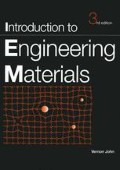Abstract
Glasses are non-crystalline or amorphous elastic solids formed by cooling from the fully molten state at a rate sufficiently rapid that crystallisation is prevented. The glass, or vitreous, state can be achieved in all classes of materials. Inorganic glasses have compositions which are the same as or similar to those of ceramics. Many polymeric materials exist in the glass state and, recently, metallic glasses have been developed. A glass is not necessarily structureless. For example, in vitreous silica the bonding between atoms is the same as in the crystalline forms of silica with each silicon atom bonded to four oxygen atoms forming an SiO4 tetrahedron. The difference is that the tetrahedra are linked together into a large symmetrical array in the crystalline forms whereas, in vitreous silica, there is no long range order (see Figure 6.2).
Preview
Unable to display preview. Download preview PDF.
Copyright information
© 1992 V. B. John
About this chapter
Cite this chapter
John, V. (1992). Glasses and Partial Crystallinity. In: Introduction to Engineering Materials. Palgrave Macmillan, London. https://doi.org/10.1007/978-1-349-21976-6_6
Download citation
DOI: https://doi.org/10.1007/978-1-349-21976-6_6
Publisher Name: Palgrave Macmillan, London
Print ISBN: 978-0-333-57715-8
Online ISBN: 978-1-349-21976-6
eBook Packages: EngineeringEngineering (R0)

